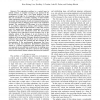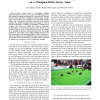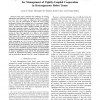IJRR
2006
14 years 3 months ago
2006
We describe the design and experimental validation of a large heterogeneous mobile robot team built for the DARPA Software for Distributed Robotics (SDR) program. The core challen...
AUTOMATICA
2010
14 years 3 months ago
2010
The ability of a robot team to reconfigure itself is useful in many applications: for metamorphic robots to change shape, for swarm motion towards a goal, for biological systems to...
ROBOCUP
1998
Springer
14 years 7 months ago
1998
Springer
Abstract. In this paper we present the hard- and software architecture of the robots of the T-Team Tuebingen, which participated in the RoboCup'98. This paper describes how we...
ROBOCUP
1999
Springer
14 years 7 months ago
1999
Springer
In RoboCup-98, sparrows team worked hard just to get both a simulation and a middle size robot team to work and to successfully participate in a major tournament. For this year, we...
IROS
2006
IEEE
14 years 9 months ago
2006
IEEE
— This paper presents an adaptive causal model method (adaptive CMM) for fault diagnosis and recovery in complex multi-robot teams. We claim that a causal model approach is effec...
ICRA
2007
IEEE
14 years 9 months ago
2007
IEEE
— The exploration problem is a central issue in mobile robotics. A complete coverage is not practical if the environment is large with a few small hotspots, and the sampling cost...
ICRA
2008
IEEE
14 years 9 months ago
2008
IEEE
— After several years of developing multiple RoboCup small-size robot soccer teams, our CMDragons robot team achieved a highly successful level of performance, winning both the 2...
ICRA
2009
IEEE
14 years 9 months ago
2009
IEEE
— This paper addresses the challenge of forming appropriate heterogeneous robot teams to solve tightly-coupled, potentially multi-robot tasks, in which the robot capabilities may...



